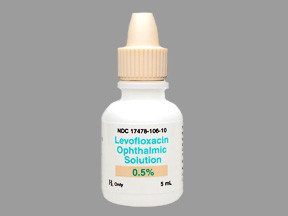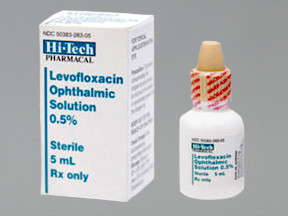LEVOFLOXACIN DROPS - OPHTHALMIC
PHONETIC PRONUNCIATION: (LEE-voe-FLOX-a-sin)
COMMON BRAND NAME(S): Quixin
GENERIC NAME(S): levofloxacin
Uses
USES: This medication is used to treat bacterial eye infections. Levofloxacin belongs to a class of drugs known as quinolone antibiotics. It works by stopping the growth of bacteria. This medication treats only bacterial eye infections. It will not work for other types of eye infections. Using any antibiotic when it is not needed can cause it to not work for future infections.
How to use LEVOFLOXACIN DROPS - OPHTHALMIC
HOW TO USE: This medication is applied to the eye(s) as directed by your doctor. To apply eye drops, wash hands first. To avoid contamination, do not touch the dropper tip or let it touch your eye or any other surface. Do not wear contact lenses while you are using this medicine. Sterilize contact lenses according to the manufacturer's directions, and check with your doctor before you begin using them again. Tilt your head back, look upward, and pull down the lower eyelid to make a pouch. Hold the dropper directly over your eye and place one drop into the pouch. Look downward, gently close your eyes, and place one finger at the corner of your eye (near the nose). Apply gentle pressure for 1 to 2 minutes before opening your eyes. This will prevent the medication from draining out. Try not to blink or rub your eye. Repeat these steps if your dose is for more than one drop. If directed to use this medication in both eyes, repeat these steps for your other eye. Do not rinse the dropper. Replace the dropper cap after each use. If you are using another kind of eye medication (such as drops or ointments), wait at least 5 minutes before applying other medications. Use eye drops before eye ointments to allow the drops to enter the eye. Use this medication regularly to get the most benefit from it. To help you remember, use it at the same time(s) each day. Continue to use this medication for the full time prescribed, even if symptoms disappear after a few days. Stopping the medication too early may allow bacteria to continue to grow, which may result in a return of the infection. Tell your doctor if your condition lasts or gets worse.
Side Effects
Precautions
Interactions
Overdose
Images
Reviews
Disclaimer
IMPORTANT: HOW TO USE THIS INFORMATION: This is a summary and does NOT have all possible information about this product. This information does not assure that this product is safe, effective, or appropriate for you. This information is not individual medical advice and does not substitute for the advice of your health care professional. Always ask your health care professional for complete information about this product and your specific health needs.



No Reviews Yet